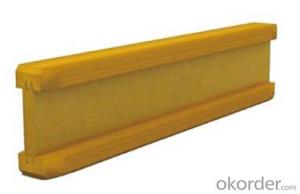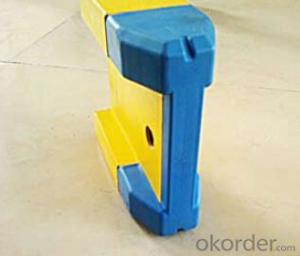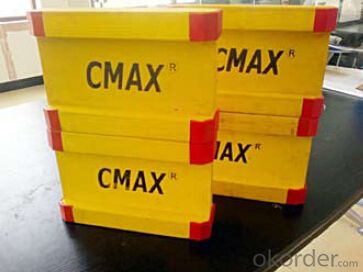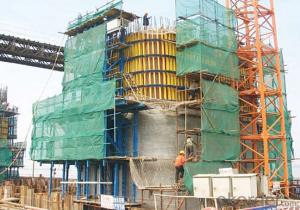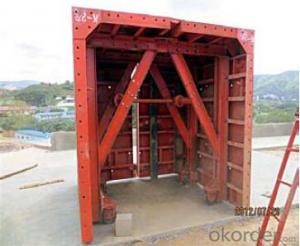Timber-Beam for Formwork and scaffolding system
- Loading Port:
- Tianjin
- Payment Terms:
- TT OR LC
- Min Order Qty:
- 50 m²
- Supply Capability:
- 1000 m²/month
OKorder Service Pledge
OKorder Financial Service
You Might Also Like
Characteristics:
◆ Standardized production lines.
Supply capability: 3000m/day, Lmax = 6600mm.
◆ Finger jointing of the flange and web, the strength of timber beam is highly improved.
Max. shearing force failure load:40KN
◆ Well treated to prevent from water penetration or erosion, so the service life maximally extended.
Normally, CNBM timber beam H20 can be used for 4 to 5 years, the exact using time would depend on maintenance & storage.
◆ Robust caps at the end of the girders protect against damages.
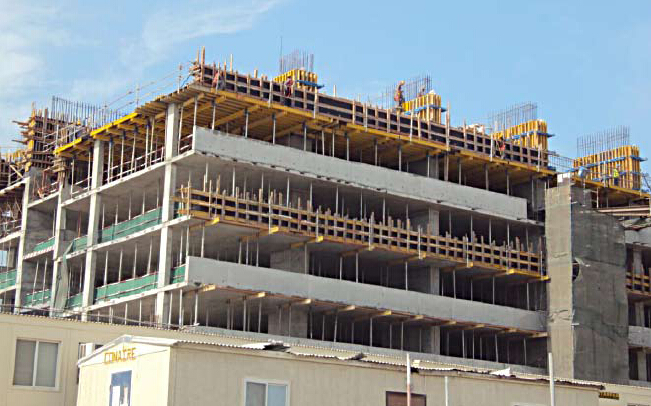
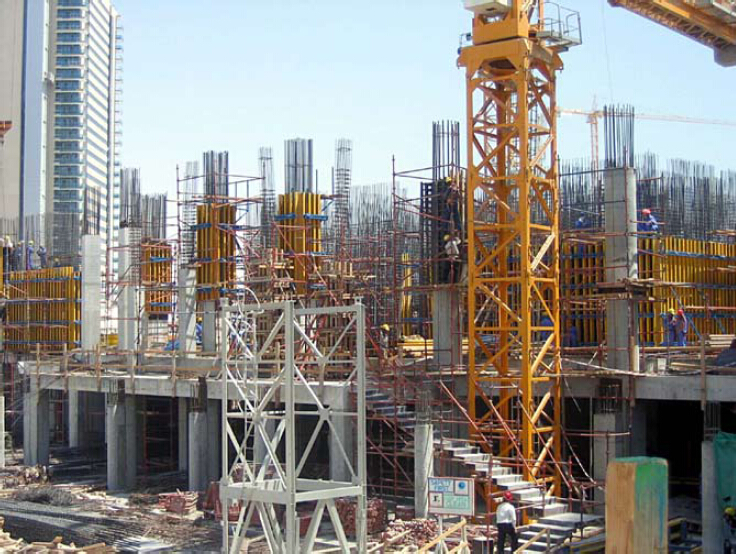
- Q: Can steel formwork be used for both interior and exterior structures?
- Yes, steel formwork can be used for both interior and exterior structures. Steel formwork is versatile and can withstand various environmental conditions, making it suitable for both indoor and outdoor construction projects.
- Q: Can steel formwork be used for elevated walkways?
- Yes, steel formwork can be used for elevated walkways. Steel formwork offers high strength, durability, and stability, making it suitable for supporting the weight and load of an elevated walkway. Additionally, steel formwork provides a smooth and level surface, ensuring a safe and stable walking platform for pedestrians.
- Q: Plastic building templates where there is an urgent need to solve
- Plastic building template is an energy-saving and environment-friendly products, after the wooden template, composite steel formwork, bamboo plywood, all steel template and a new type of product. Can completely replace the steel formwork, formwork, timber, traditional energy saving and environmental protection, low cost amortization
- Q: Can steel formwork be used for architectural features?
- Yes, steel formwork can be used for architectural features. Steel formwork provides strength, durability, and flexibility, making it suitable for creating complex and intricate architectural designs. It allows for precise shaping, smooth finishes, and efficient construction processes, making it a popular choice for architectural features such as decorative facades, columns, beams, and other structural elements.
- Q: Can steel formwork be used for both interior and exterior concrete finishes?
- Yes, steel formwork can be used for both interior and exterior concrete finishes. Its durability and strength make it suitable for various construction projects, providing a smooth and uniform surface finish for both indoor and outdoor applications.
- Q: Is steel formwork suitable for all types of concrete structures?
- When considering formwork options for concrete structures, steel formwork is often deemed suitable. However, its appropriateness can be influenced by various factors including design requirements, budget constraints, and project timeline. Steel formwork boasts several advantages compared to alternative systems. Its exceptional strength and durability enable it to withstand the pressure exerted by fresh concrete without warping or deforming. As a result, it is particularly well-suited for structures that necessitate substantial concrete pours or possess intricate geometries. Furthermore, steel formwork guarantees excellent dimensional accuracy, ensuring that the final concrete structure meets the prescribed specifications. Additionally, it allows for easy customization, enabling tailoring to the specific needs of the project. Nevertheless, there are situations where steel formwork may not be the most appropriate choice. For instance, if budget limitations exist, steel formwork may prove costlier than alternatives like timber or plastic formwork. Moreover, if the project operates on a tight schedule, steel formwork may necessitate more time for fabrication and assembly compared to other systems. Moreover, steel formwork may not be the optimal selection for structures with stringent aesthetic requirements. The steel panels may leave imprints on the concrete surface, which may not align with certain architectural designs. In conclusion, although steel formwork is generally suitable for a broad array of concrete structures, its suitability may fluctuate based on project-specific factors such as design requirements, budget, and timeline. It is vital to meticulously evaluate these factors before determining the most fitting formwork system for a particular project.
- Q: Can steel formwork be used for precast concrete facades?
- Yes, steel formwork can be used for precast concrete facades. Steel formwork provides a strong and durable framework for casting precast concrete panels and is commonly used in the construction industry for various applications, including facades. It offers the advantage of being reusable, allowing for cost savings and faster construction times. Additionally, steel formwork can be easily customized to create intricate designs and complex shapes, making it a suitable choice for precast concrete facades.
- Q: What are the different types of steel formwork clamps and connectors?
- There are several different types of steel formwork clamps and connectors used in construction projects. These clamps and connectors play a crucial role in holding the formwork together and maintaining its stability during the casting of concrete. Here are some of the common types: 1. Wedge clamps: These clamps are widely used and consist of a wedge-shaped piece that locks the formwork panels tightly together. They are easy to install and remove, making them popular for temporary formwork. 2. Rapid clamps: These clamps are designed for quick installation and removal. They have a spring-loaded mechanism that allows for easy adjustment and tightening. Rapid clamps are often used in situations where speed is essential, such as high-rise construction. 3. Scaffold clamps: As the name suggests, these clamps are used to connect formwork to scaffolding systems. They provide a secure connection between the two, ensuring stability and safety during construction. 4. Column clamps: These clamps are specifically designed for connecting formwork panels around columns or pillars. They come in various sizes to accommodate different column diameters and provide a strong and stable connection. 5. Corner clamps: Corner clamps are used to connect formwork panels at corners, ensuring a tight fit and preventing any gaps. They are adjustable, allowing for flexibility in formwork design and easy alignment of panels. 6. Beam clamps: These clamps are used to secure formwork panels to horizontal beams or joists. They provide a sturdy connection and help distribute the load evenly, ensuring the stability of the formwork system. 7. Pin and wedge connectors: These connectors consist of steel pins and wedges that are used to join formwork panels together. The pins are inserted into pre-drilled holes, and the wedges are hammered in to create a tight connection. Pin and wedge connectors offer a reliable and durable solution. 8. Tie rods and wing nuts: These components are used in conjunction with clamps to provide additional support and reinforcement to the formwork system. Tie rods are threaded steel rods that are inserted through the formwork panels and secured with wing nuts, creating a strong and rigid connection. It is important to note that the specific types of clamps and connectors used may vary depending on the project requirements and the formwork system being used. Consulting with a structural engineer or formwork supplier is recommended to determine the most suitable clamps and connectors for a particular construction project.
- Q: What is the difference between the steel template and the wood template? When to use steel formwork? When to use a wooden template?Now what kind of use
- Wood template is artificial site processing, the use of a variety of complex structural modeling, and now use the glue template is also a lot, in addition to good heat dissipation of steel templates, the use of large steel formwork is good
- Q: What are the different types of connections used in steel formwork?
- There are several different types of connections commonly used in steel formwork, each with its own advantages and applications. Some of the most common types include: 1. Bolted connections: These connections involve using bolts and nuts to secure the formwork components together. Bolted connections are versatile, relatively easy to assemble and disassemble, and provide a high level of strength and stability. They are often used for larger formwork structures or where high loads are expected. 2. Welded connections: Welding is another popular method of connecting steel formwork components. Welded connections offer excellent strength and durability, as the pieces are fused together. However, welding requires skilled labor and specialized equipment, which can increase costs and time. 3. Clamped connections: Clamped connections involve using clamps or couplers to hold the formwork components together. Clamped connections are quick to assemble and disassemble, making them ideal for temporary structures or situations where frequent changes are required. They also offer flexibility in terms of adjusting the formwork components' position. 4. Pin connections: Pin connections involve using pins or dowels to join the formwork components together. These connections are relatively simple and can be quickly assembled or disassembled. However, pin connections may not offer the same level of strength as bolted or welded connections. 5. Adhesive connections: Adhesive connections involve using an adhesive or epoxy to bond the formwork components together. This type of connection is commonly used for smaller or lightweight formwork structures. Adhesive connections provide a strong bond and are often used in situations where welding or bolting is not feasible. Each type of connection has its own advantages and disadvantages, and the choice depends on factors such as the formwork structure's size, load requirements, desired level of strength, and project timeline. Consulting with a structural engineer or formwork specialist can help determine the most suitable connection type for a specific project.
Send your message to us
Timber-Beam for Formwork and scaffolding system
- Loading Port:
- Tianjin
- Payment Terms:
- TT OR LC
- Min Order Qty:
- 50 m²
- Supply Capability:
- 1000 m²/month
OKorder Service Pledge
OKorder Financial Service
Similar products
Hot products
Hot Searches
Related keywords

